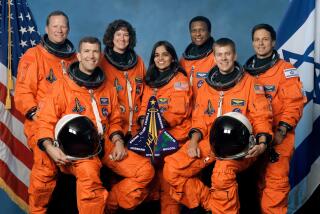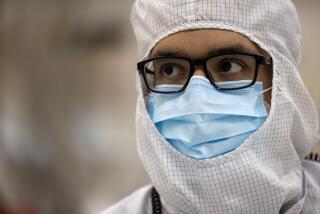Shuttle Telescopes Pass Crew’s Post-Launch Inspection : Space: The sensitive instruments appear to be in excellent shape after the rigors of liftoff. Scientists are to start probing secrets of the universe today.
HUNTSVILLE, Ala. — The pioneering telescopes aboard the space shuttle Columbia went into service Sunday night and began an extraordinary reconnaissance of the universe.
“Everything looks fine, just like the book says,” astronomer Ronald A. Parise, a civilian member of the crew, told mission control here.
“It’s perfect,” said Arthur Davidsen, chief scientist for Johns Hopkins University’s ultraviolet telescope, one of three such instruments aboard the shuttle. “Everything works exactly as planned.”
Scientists were planning to concentrate on their first “targets” early today, including two stars that revolve rapidly around each other.
But the first day of the 10-day mission was devoted to making sure that the sensitive telescopes aboard the shuttle survived the rigors of Sunday morning’s launch. All reports indicated that the instruments were in excellent shape, although engineers were working on a few minor problems.
“There have been three big thrills for the scientists,” said Steve Maren, an astronomer with the Goddard Space Flight Center. “The first was the launch,” a long-delayed event that scientists have been awaiting for several years.
“The second was the erection of the instrument pointing system,” which will keep the telescopes trained on some of the most active objects in the universe with pinpoint precision, Maren said.
“The third was first call,” the moment when scientists on the ground at the Marshall Space Flight Center here began talking with their colleagues in space, an extraordinary link between experts on the ground and four astronomers who are for the first time practicing their art in space.
“Huntsville, this is Astro,” Mission Specialist Robert A. R. (Bob) Parker, an astronomer as well as a career astronaut, told mission control, indicating that the link between orbiting scientists and their colleagues on the ground had been established. This is the first flight to be controlled out of the space center here instead of the Johnson Space Center in Houston.
The Astro mission has been eagerly awaited by scientists because the telescopes will look at the universe in wavelengths of light--ultraviolet and X-rays--that are filtered out by the atmosphere and do not reach the Earth. Ultraviolet light and X-rays are emitted by objects that are many times hotter than the sun, and thus they are remnants of some of the most violent events in the universe--such things as the birth and death of stars.
Three of the telescopes will radio data back as it is collected, so scientists won’t have to wait to see their results. That includes the University of Wisconsin’s Ultraviolet Photo-Polarimeter Experiment, dubbed WUPPE, which is pronounced just the way it looks; Goddard Space Flight Center’s Broad Band X-Ray Telescope, and the Hopkins telescope.
Only the fourth instrument, Goddard’s Ultraviolet Imaging Telescope, will capture all of its data on film. Scientists working on that project will have to wait until the shuttle lands to see whether they have been successful.
This will be a busy flight, with the seven crewmen divided into two teams that will alternate on 12-hour watches.
The Columbia is skippered by Vance D. Brand, 58, the oldest man to fly in space. The pilot is Guy S. Gardner. The other members of the crew are civilian astronomer Samuel T. Durrance, astronaut/astronomer Jeffrey A. Hoffman and astronaut John M. Lounge.






